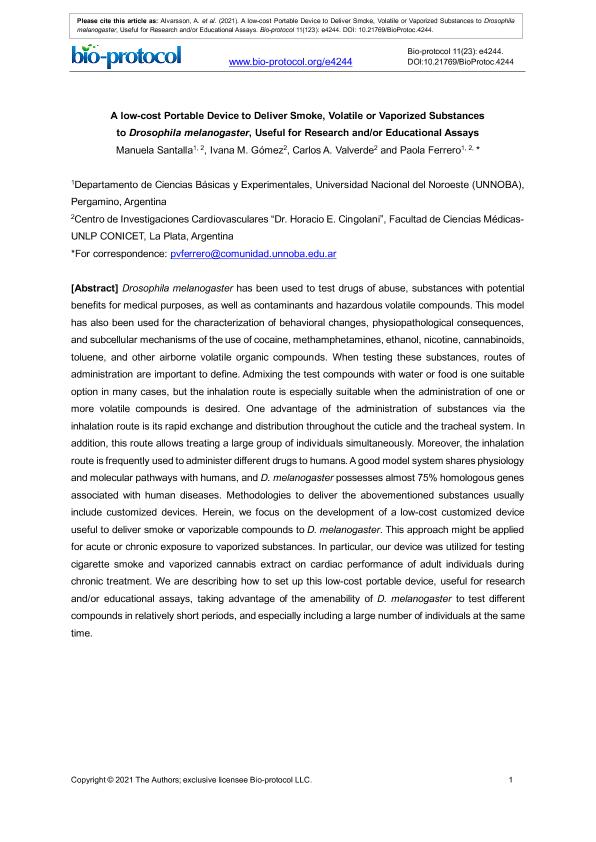Mostrar el registro sencillo del ítem
dc.contributor.author
Santalla, Manuela

dc.contributor.author
Gómez, Ivana María

dc.contributor.author
Valverde, Carlos Alfredo

dc.contributor.author
Ferrero, Paola Viviana

dc.date.available
2022-12-14T15:09:48Z
dc.date.issued
2021-12
dc.identifier.citation
Santalla, Manuela; Gómez, Ivana María; Valverde, Carlos Alfredo; Ferrero, Paola Viviana; A low-cost Portable Device to Deliver Smoke, Volatile or Vaporized Substances to Drosophila melanogaster, Useful for Research and/or Educational Assays; Bio-protocol LLC; Bio-protocol; 11; 23; 12-2021; 1-13
dc.identifier.issn
2331-8325
dc.identifier.uri
http://hdl.handle.net/11336/181143
dc.description.abstract
Drosophila melanogaster has been used to test drugs of abuse, substances with potential benefits for medical purposes, as well as contaminants and hazardous volatile compounds. This model has also been used for the characterization of behavioral changes, physiopathological consequences, and subcellular mechanisms of the use of cocaine, methamphetamines, ethanol, nicotine, cannabinoids, toluene, and other airborne volatile organic compounds. When testing these substances, routes of administration are important to define. Admixing the test compounds with water or food is one suitable option in many cases, but the inhalation route is especially suitable when the administration of one or more volatile compounds is desired. One advantage of the administration of substances via the inhalation route is its rapid exchange and distribution throughout the cuticle and the tracheal system. In addition, this route allows treating a large group of individuals simultaneously. Moreover, the inhalation route is frequently used to administer different drugs to humans. A good model system shares physiology and molecular pathways with humans, and D. melanogaster possesses almost 75% homologous genes associated with human diseases. Methodologies to deliver the abovementioned substances usually include customized devices. Herein, we focus on the development of a low-cost customized device useful to deliver smoke or vaporizable compounds to D. melanogaster. This approach might be applied for acute or chronic exposure to vaporized substances. In particular, our device was utilized for testing cigarette smoke and vaporized cannabis extract on cardiac performance of adult individuals during chronic treatment. We are describing how to set up this low-cost portable device, useful for research and/or educational assays, taking advantage of the amenability of D. melanogaster to test different compounds in relatively short periods, and especially including a large number of individuals at the same time.
dc.format
application/pdf
dc.language.iso
eng
dc.publisher
Bio-protocol LLC
dc.rights
info:eu-repo/semantics/openAccess
dc.rights.uri
https://creativecommons.org/licenses/by-nc-sa/2.5/ar/
dc.subject
ADULT FLIES
dc.subject
CANNABIS
dc.subject
CUSTOM-MADE DEVICE
dc.subject
DROSOPHILA MELANOGASTER
dc.subject
INHALATION
dc.subject
SMOKE
dc.subject
VAPORIZED SUBSTANCES
dc.subject.classification
Otras Ingenierías y Tecnologías

dc.subject.classification
Otras Ingenierías y Tecnologías

dc.subject.classification
INGENIERÍAS Y TECNOLOGÍAS

dc.title
A low-cost Portable Device to Deliver Smoke, Volatile or Vaporized Substances to Drosophila melanogaster, Useful for Research and/or Educational Assays
dc.type
info:eu-repo/semantics/article
dc.type
info:ar-repo/semantics/artículo
dc.type
info:eu-repo/semantics/publishedVersion
dc.date.updated
2022-09-07T17:21:31Z
dc.journal.volume
11
dc.journal.number
23
dc.journal.pagination
1-13
dc.journal.pais
Estados Unidos

dc.journal.ciudad
California
dc.description.fil
Fil: Santalla, Manuela. Consejo Nacional de Investigaciones Científicas y Técnicas. Centro Científico Tecnológico Conicet - La Plata. Centro de Investigaciones Cardiovasculares "Dr. Horacio Eugenio Cingolani". Universidad Nacional de La Plata. Facultad de Ciencias Médicas. Centro de Investigaciones Cardiovasculares "Dr. Horacio Eugenio Cingolani"; Argentina
dc.description.fil
Fil: Gómez, Ivana María. Consejo Nacional de Investigaciones Científicas y Técnicas. Centro Científico Tecnológico Conicet - La Plata. Centro de Investigaciones Cardiovasculares "Dr. Horacio Eugenio Cingolani". Universidad Nacional de La Plata. Facultad de Ciencias Médicas. Centro de Investigaciones Cardiovasculares "Dr. Horacio Eugenio Cingolani"; Argentina
dc.description.fil
Fil: Valverde, Carlos Alfredo. Consejo Nacional de Investigaciones Científicas y Técnicas. Centro Científico Tecnológico Conicet - La Plata. Centro de Investigaciones Cardiovasculares "Dr. Horacio Eugenio Cingolani". Universidad Nacional de La Plata. Facultad de Ciencias Médicas. Centro de Investigaciones Cardiovasculares "Dr. Horacio Eugenio Cingolani"; Argentina
dc.description.fil
Fil: Ferrero, Paola Viviana. Consejo Nacional de Investigaciones Científicas y Técnicas. Centro Científico Tecnológico Conicet - La Plata. Centro de Investigaciones Cardiovasculares "Dr. Horacio Eugenio Cingolani". Universidad Nacional de La Plata. Facultad de Ciencias Médicas. Centro de Investigaciones Cardiovasculares "Dr. Horacio Eugenio Cingolani"; Argentina. Universidad Nacional del Noroeste de la Provincia de Buenos Aires; Argentina
dc.journal.title
Bio-protocol
dc.relation.alternativeid
info:eu-repo/semantics/altIdentifier/url/https://bio-protocol.org/e4244
dc.relation.alternativeid
info:eu-repo/semantics/altIdentifier/doi/http://dx.doi.org/10.21769/BioProtoc.4244
Archivos asociados
